Preparations are underway for Prime Minister Pushpa Kamal Dahal’s visit to India. Although Dahal is yet to receive a formal invitation from India, his team expects it to arrive any day now and they are preparing accordingly.
The prime minister’s trip will likely focus on enhancing the development partnership between Nepal and India.
The 2022 Annual Report of the Ministry of External Affairs of India states that cross-border connectivity projects, such as rail links, roads, and Integrated Check Posts (ICPs), are progressing well.
During Indian Foreign Secretary Vinay Mohan Kwatra’s recent visit to Kathmandu, too, the two sides reviewed the projects and expressed satisfaction with the progress made.
In recent years, Nepal and India have completed several major flagship projects, including the first-ever cross-border petroleum products pipeline in South Asia—from Motihari in India to Amlekhgunj in Nepal. The project was completed in 2019 and is already operational, facilitating the supply of petroleum products. Further discussions are underway to extend the pipeline to Chitwan in central Nepal, as well as to construct a new pipelines in eastern Nepal.
Significant progress has been made in improving cross-border connectivity as well. Two Integrated Check Posts (ICPs), located at Birgunj and Biratnagar, are fully operational, facilitating the movement of approximately two million passengers and cargo traffic annually. Furthermore, additional ICPs are under construction, indicating the commitment to further enhancing cross-border trade and transportation.
In the field of power transmission, three cross-border power transmission lines have been constructed, supplying 600 MW of electricity to Nepal, which has contributed to the development of the country’s energy infrastructure.
Road connectivity projects have also gained momentum, with India’s assistance in the construction of 807 km out of the 1,024 km-long East-West Highway in Nepal. As of December 2022, all 14 Tarai road packages, completed under Indian assistance of Rs 5bn, have been handed over to Nepal. Several other roads are also under construction.
Progress in the development of cross-border rail networks between Nepal and India has also been encouraging. The railway projects between the two countries include the operationalization of the Jayanagar-Bardibas cross-border section and Jogbani-Nepal customs yard rail section. In June 2022, a Bharat Gaurav train was flagged off, connecting the holy city of Janakpur in Nepal with Ramayana circuit locations in India. The Jayanagar-Kurtha stretch of the Jayanagar-Bardibas broad gauge project was also launched and operationalized in April 2022. There has been notable progress in the construction of a 136-km broad gauge electrified railway line that will connect Kathmandu with Raxaul. The Indian side has already completed the preliminary survey, and the location survey tasks are currently underway. It is worth mentioning that this railway line coincides with China’s plan to construct the Kathmandu-Kerung railway line, for which a Chinese team is conducting a feasibility study.
Likewise, there has been visible progress in bilateral energy cooperation. In 2022, the two countries signed a joint vision statement on power sector cooperation, outlining key pillars for collaboration. These include joint development of power generation projects in Nepal, cross-border transmission infrastructure, bi-directional power trade, coordinated operation of national grids, and institutional cooperation in sharing the latest operation information, technology, and know-how. Furthermore, hydropower projects being executed by Indian companies are progressing well. Large hydroelectric projects, such as Arun III (900 MW), Lower Arun (679 MW), Arun-4 (490 MW), West Seti and SR-6 (1200 MW), and Upper Karnali (900 MW), are currently being developed by Indian companies. In the past, there were criticisms regarding the sluggish progress of these projects, but they have picked up pace in the recent years.
Prime Minister Dahal’s imminent India visit also comes at an exciting new development in Nepal. For the first time in history, Nepal has become energy surplus and even started exporting power to India. India has agreed to import more than 400 MW electricity from Nepal. To this end, Nepal exported power worth Rs 6bn in the summer of 2022.








